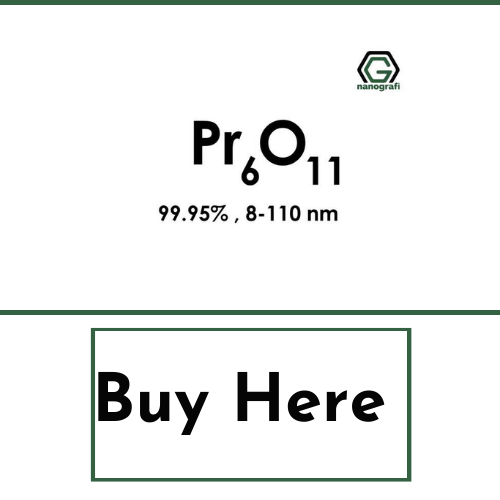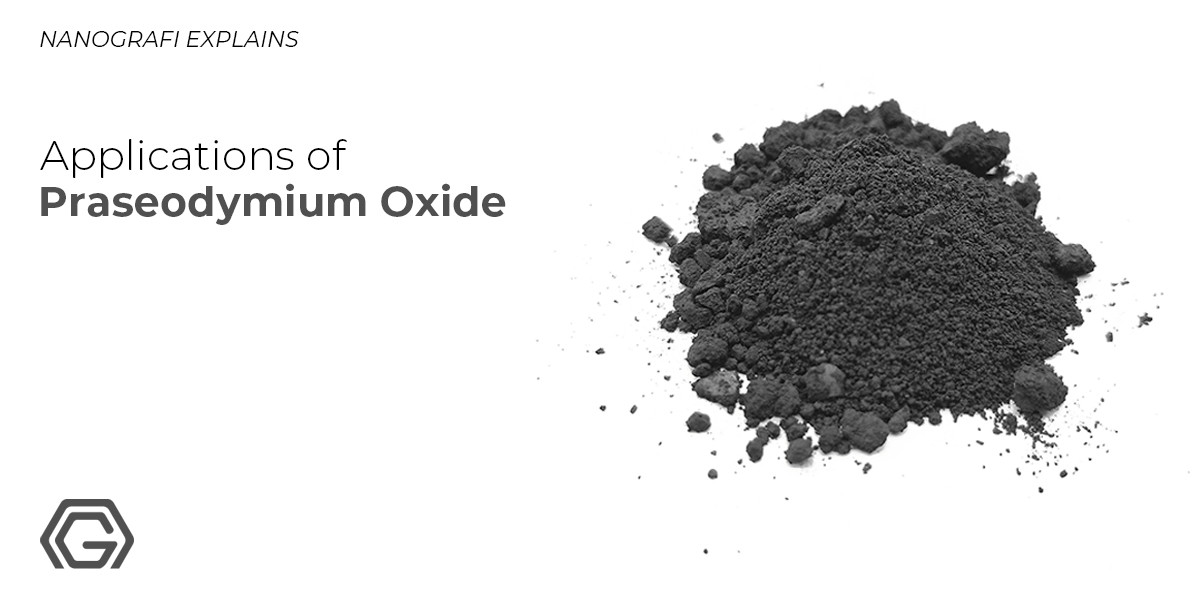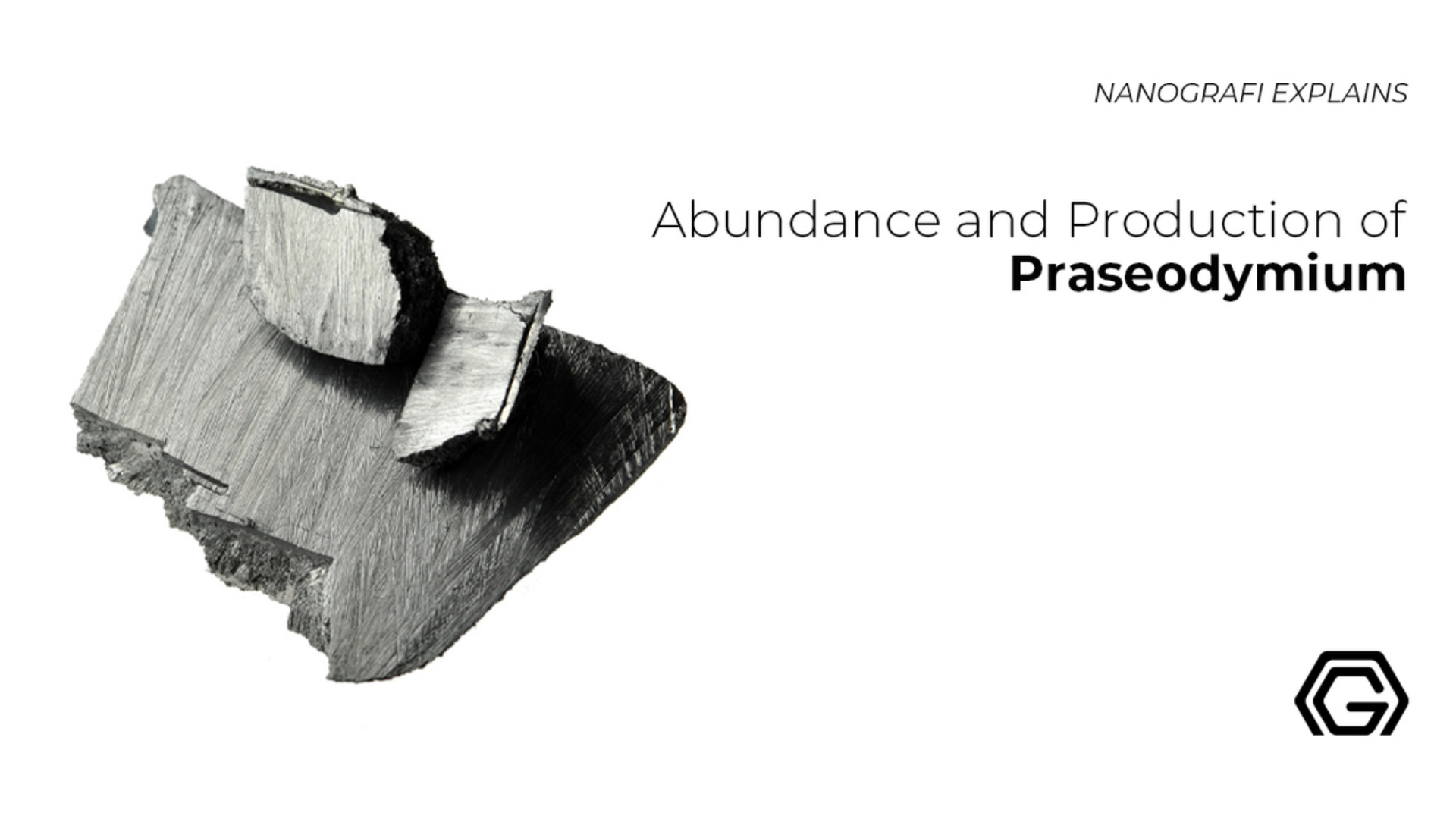Applications of Praseodymium Oxide
This article focuses on one of the Earth's rare metal which falls under the lanthanide group in the periodic table. Praseodymium Greek meaning is a green twin. It is a metal that is malleable. When exposed with air, Praseodymium turns into praseodymium oxide.
In all the processes that make Praseodymium oxide, calcination is done in all of them. The physical properties of prepared nanoparticles depend strongly on conditions of calcination. Pr6O11 has a cubic fluorite structure of a crystal.The characteristic that makes its oxides very useful in catalytic activity is of the Pr ions being in a mixed state of valency, Pr(III), and Pr(IV). P
Introduction
Praseodymium Oxide Pr2O3 melting point is 2200 C and is light green in colour. Pr6O11 is the most stable one at room temperature as well as in the air. Praseodymium (III) oxide is also used in welding goggles and can also be used to colour ceramics and glass yellow. It can be seen in household equipment, for example, fluorescent lamps, colour televisions, glasses, and energy-saving lamps. Praseodymium's usage is still growing because it is well-suited to polish gas and to produce catalyzers. Praseodymium is a typical metal, like iron, magnesium, or aluminium. It is quite expensive to prepare and does not have many practical uses. The chief applications are, as a magnetic material, as a catalyst, as a dried powder when mixed with the binder is useful in plasma spray guns and coating.

Praseodymium Oxide (Pr6O11)
Praseodymium is a silvery-yellow and softly malleable metal. In the periodic table, it is a lanthanide group's member and rare earth metal. It reacts with oxygen slowly and water rapidly. On exposure with air, Praseodymium produces a green oxide or a flaky black oxide coating (Pr6O11) which does not further prevent it from oxidation. In the air, it is more resistant to corrosion than other rare metals, but it should be coated with plastic or stored under oil. Pr2O3, green sesquioxide, is unstable in air. On reaction with water, praseodymium hydroxide and hydrogen gas are formed from Praseodymium. It usually exists as a trivalent ion, Pr3+. Praseodymium salts have a pale green colour. In 1885, Austrian scientist Carl Auer von Welsbach identified Praseodymium in Vienna for the first time. In 1871, he discovered 'didymium' and realized in 1885 that it was two new elements mixture named as neodymium and Praseodymium. He fractionally crystallized nitrate salts (made by reaction with didymium) from nitric acid to yield pink neodymium salts and greenish-brown Praseodymium. 'prasios-didymos' is a Greek word which means 'green twin,' reflecting its close association with neodymium and the green salts. In 1931, pure metallic Praseodymium was first produced. Praseodymium is used in iPods, aircraft engines, hybrid car electric motors and generators, and studio lighting.
Praseodymium oxide or Praseodymium(III) oxide is the chemical compound composed of oxygen and Praseodymium with the formula Pr2O3. White hexagonal crystals are formed. Praseodymium(III) oxide crystallizes in the bixbyite structure or manganese(III) oxide. Praseodymium (III, IV) oxide, Pr6O11 is the inorganic compound that's not soluble in water having a cubic fluorite structure. Pr6O11 is praseodymium oxide's most stable form at ambient pressure and temperature. It is a highly insoluble Praseodymium source suitable for ceramic, Glass, and optic applications. It is easily available in all volumes. Both the usefulness and optical quality is increased because of ultra-high purity and high purity compositions. Nanoscale elemental powders and suspensions, as alternative high surface area forms, may be considered. Praseodymium oxide, Pr2O3, produces medium-index film layers that are transparent throughout the visible region. The films are hard and insoluble. Praseodymium oxides represent phases system with variable composition, even though being restricted to a well-defined range.
Praseodymium oxide can be:
Praseodymium(III,IV) oxide, Pr6O11
- Praseodymium(III) oxide Pr2O3
- Praseodymium(IV) oxide PrO2
Synthesis
Nanoparticles of Praseodymium oxide are normally made through solid-state methods, for example, molten salt method, precipitation, thermolysis, and calcination. For obtaining nanoparticles of a crystalline Pr6O11, a calcination step is in all processes.
Calcination
Typically, praseodymium (III, IV) oxide is obtained by heating praseodymium hydroxide Pr(OH)3 or praseodymium nitrate Pr(NO3)36H2O under air, at temperature more than 500 °C. The report shows that it can also be obtained by synthesis from some other organic precursors, for instance, Oxalate, malonate, and praseodymium acetate. Physical properties such as particle shape or lattice parameter of prepared nanoparticles depend strongly on calcination conditions, for instance, the duration or temperature, and also, different methods of preparation.
To get more information about praseodymium,
you can read our blog post here.
Properties of Praseodymium Oxide
Praseodymium's atomic number is 59; atomic mass is 140.91 g.mol -1, electronegativity is 1.1, density is 6.8 g.cm-3 at 20°C, melting point is 931 °C, the boiling point is 3512 °C, the Ionic radius is 0.101 nm, Isotopes are 5, Energy of first ionization is 522 kJ.mol -1 Energy of second ionization is 1016 kJ.mol -1, Energy of third ionization is 2082.4 kJ.mol -1, Energy of fourth ionization is 3752 kJ.mol -1. The Energy of the fifth ionization is 5534 kJ.mol -1, with -2.47 V standard potential.
A cubic fluorite structure of the crystal is adopted by Pr6O11. The characteristic that makes its oxides very useful in catalytic activity is of the Pr ions being in a mixed state of valency, Pr(III), and Pr(IV). It can be considered as praseodymium (IV) oxide's (PrO2) oxygen-deficient form. An electron beam source is required by the films of praseodymium oxide for reaching the temperature of evaporation. Less than 150° C substrate temperature is required to deposit amorphous films. Films become crystalline on more than 300C. The transparent region is from 400nm to 3um. The Refractive index at 400nm is 1.75-1.8, and at 500-700nm, it is 1.75-1.70. Praseodymium Oxide Pr2O3 molecular weight is 329.81, melting point is 2200 C, and is light green in colour. Its crystal density is 7.07 g/cc. Pr6O11 is the most stable one at room temperature as well as in air; also, terminologies like PrO1.833 and Pr6O11 are completely equivalent. Through simple cooling (or heating), phases can be easily interconverted and can suitably adjust the atmosphere's oxygen content in contact with the solid.
Applications of Praseodymium Oxide
Praseodymium(III) oxide could also be used in combination with silicon as a dielectric. Didymiumglass, which is a glass doped with Praseodymium, turns into yellow colour and due to the ability to block infrared radiation, it is also used in welding goggles. Praseodymium (III) oxide can also be used to colour ceramics and glass yellow. Pr6O11, and Praseodymium (III, IV) oxide, which is a brown mixed-valence compound, is used for colouring ceramics. A metal important use is in a pyrophoric alloy that's used in lighter flints of cigarettes. Praseodymium compounds have many different uses: the oxide lights up the arc in carbon electrodes, and it can give yellow colour to the Glass. Infrared radiation is filtered out by the Glass due to which it's suitable to be used in goggles that the welder wears to protect his eyes. Glass and enamel are coloured by the salts. Praseodymium with magnesium can also be used as an alloying agent which creates metal of high strength that is used in an engine of an aircraft.
One of the rare chemicals is Praseodymium that can be seen in household equipment, for example, fluorescent lamps, colour televisions, glasses, and energy-saving lamps. Comparable properties are acquired by all the rare chemicals. Praseodymium's usage is still growing because it is well-suited to polish gas and to produce catalyzers.
Praseodymium in The Environment
One of the most abundant rare earth elements is Praseodymium. It is normally found in ores of two different kinds, and It is four times more abundant than tin. In chemical catalysis, Praseodymium (III, IV) oxide has a lot of potential applications, and it improves its catalytic performance by being used in conjunction with a promoter such as gold or Sodium.
Oxidative Coupling of Methane
Lithium or Sodium promoted praseodymium (III, IV) oxide shows great methane conversion rate with a good selectivity towards ethene and ethane and not towards byproducts like carbon dioxide that aren't even wanted. The reaction's precise mechanism is still being discussed, but it has been advised that normally, by oxygen on the catalyst's surface, methane is activated to a methyl radical which both then combines to form ethane. Then, spontaneously or through the catalyst, reduction of ethane occurs forming ethene. Pr(III) and Pr(IV), multiple oxidation states enables fast regeneration of the active catalyst species involving a peroxide anion O22-. Hydrocarbons of higher order are obtained from the conversion of abundant methane gas which is composed of natural gas up to 60%, that's why this reaction is of great interest. More applications are provided by high order hydrocarbons. As a result, methane's oxidative coupling is a desirable process economically.
CO Oxidation
For the Pr6O11-catalysed oxidation of CO into CO2, the CO binds to the surface of the catalyst first, to make a bidentate carbonate. Now in order to complete the catalytic cycle, bidentate carbonate is then converted into a mono-dentate carbonate specie which is then decomposed as CO2. Conversion into the mono-dentate specie causes the catalyst to leave an oxygen vacancy on its surface, which has the potential to be filled quickly because of oxygen's high mobility that's deriving from the Pr centres mixed oxidation states. The proposed mechanism is presented here, schematically. Gold promoters addition to the catalyst can lessen the temperature from 550 °C to 140 °C. It is assumed to have a significant synergistic effect between Praseodymium (III, IV) oxide species and gold. Oxidation of CO is interested because of its ability to obtain non-toxic CO2 from toxic CO gas, and it also has applications in the car exhaust, like, that emits CO. Pr6O11 is also used in conjunction with other additives such as zircon or silica to produce pigments for use in Glass and ceramics.

Conclusion
Praseodymium is a rare metal of the lanthanide group in the periodic table. There's Praseodymium(III, IV) oxide Pr6O11, Praseodymium(III) oxide Pr2O3, Praseodymium(IV) oxide PrO2. Praseodymium turns into praseodymium oxide, i.e. flaky black or a green oxide on exposure with air. Praseodymium oxide has many remarkable properties, and it is most important in oxidation of CO and oxidative coupling of methane. It offers a variety of applications in different sectors.
To get more information, you can visit Blografi.
References
https://materion.com/resource-center/product-data-and-related-literature/inorganic-chemicals/oxides/praseodymium-oxide-pr2o3-for-optical-coating
https://www.lenntech.com/periodic/elements/pr.htm
https://en.wikipedia.org/wiki/Praseodymium(III, IV)_oxide
https://www.hindawi.com/journals/ijelc/2011/561204/
https://www.chemicool.com/elements/praseodymium.html
Recent Posts
-
What is the Difference Between 7075 and 6061 Aluminum Alloy?
When comparing 7075 aluminum alloy to 6061 aluminum alloy, it's essential to understand their disti …5th Apr 2024 -
Iron-Air Batteries: The Ultimate Guide
Iron-air batteries represent a significant breakthrough in energy storage technology, offering a sus …29th Mar 2024 -
Discovering the Power of 2D Materials
In material science, the discovery of two-dimensional (2D) materials represents a transformative de …22nd Mar 2024





